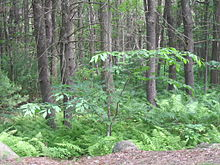BY DONALD EDWARD DAVIS
Although many Americans still associate the winter holidays with chestnuts, the tree that once produced them — the American chestnut — no longer does so, except in a few rare cases. During the first half of the 20th century, billions of chestnut trees died from an exotic fungus, which was brought into this country on Japanese chestnut stock. The loss of the American chestnut was a historic event, because the trees not only supplied nuts but also wood for home, coffin and furniture construction, and the raw material for making railroad ties, shingles, telephone poles, fences and leather tannins.
In the 21st century, there are those who believe the trees can be resuscitated via genetic engineering (GE). In fact, the U.S. Department of Agriculture (USDA) has just released a draft environmental impact statement and draft plant pest risk assessment that will allow the unrestricted planting of blight-tolerant GE chestnut trees on public and private lands. If approved, the tree would be the first genetically engineered plant released with the purpose of spreading freely into the wild. Although the agency is recommending the tree’s release into wild forests, they are also requesting public input regarding their recent decision to do so. (You can submit comments here.)
The restoration of the American chestnut is a noble undertaking that certainly deserves our serious consideration and thoughtful deliberation. If the plan is accomplished successfully, the tree would improve forest health, increase biodiversity, and provide important economic benefits for local communities. However, as an environmental historian, I am deeply concerned that individuals endorsing the unregulated status of the GE chestnut have not sufficiently educated themselves about potential problems associated with genetically modified trees.
First, trees are complex organisms that interact with other living things over many growing seasons, if not centuries. For this reason, more research is needed if we are to fully understand the impact of GE chestnuts on larger forest ecosystems. Since Castanea dentata emerged on the planet 40 million years ago, humans have interacted with the trees for 11 millennia but have studied the Cryphonectria fungus for only a single century. The supposition that genetically modified chestnut trees will behave in a specific and predictable way, based only on a decade of research, is premature, if not bad science.
Indeed, studies have shown that the genomic structure of transgenic plants can mutate as a result of gene insertion events and exhibit unexpected traits after reproducing. It is also possible that GE chestnuts, as they grow older and larger, will not be able to repel the blight, particularly if the OxO enzyme, produced by a wheat gene inserted into the DNA of the American chestnut, becomes less prevalent in mature trees. Scientists must be able to predict the future outcomes of their experiments and cannot reliably do so in the case of GE chestnuts.
However cliché it might be to state that those who do not learn the past are doomed to repeat it, in the case of the American chestnut this could very well be true. Chestnut restoration is an honorable undertaking, but the process should be done as carefully as possible, without harming the genomic heritage of this iconic tree. A wiser approach would be to adopt what the United Nations refers to as the “precautionary principle,” which restricts actions that can permanently harm a species or ecosystem, especially if there is no absolute certainty about their safety.
Is AUKUS floundering?
The US needs a sanctions policy revolution
Although the widespread cultivation and planting of American-Chinese hybrids probably would not be prohibited under the guidelines of the principle, transgenic chestnuts do not, at present, meet that threshold.
Obviously, the best option moving forward would be to have Castanea dentata thriving again in the eastern U.S. deciduous forest, since it was that tree, and not others, that shaped the human and natural communities of North America.
